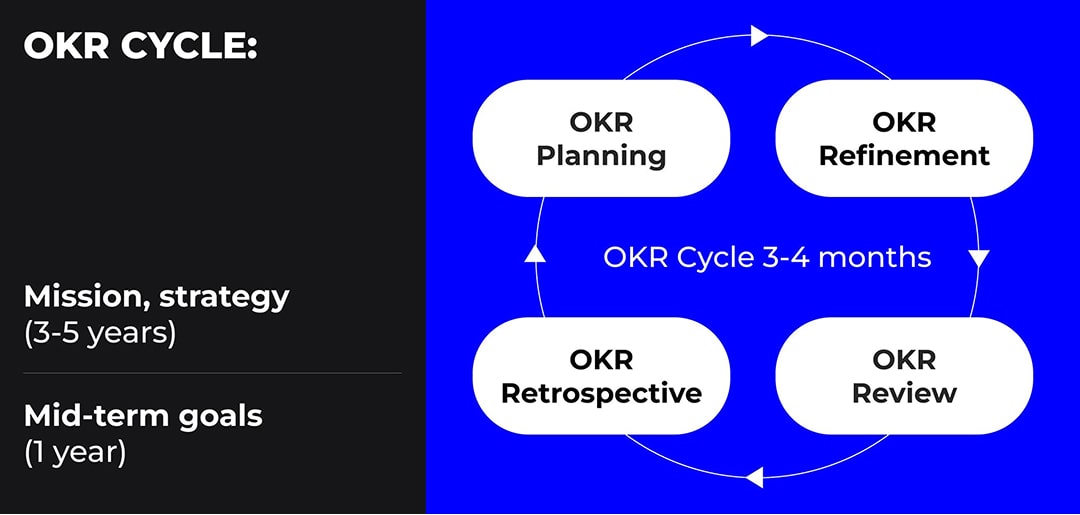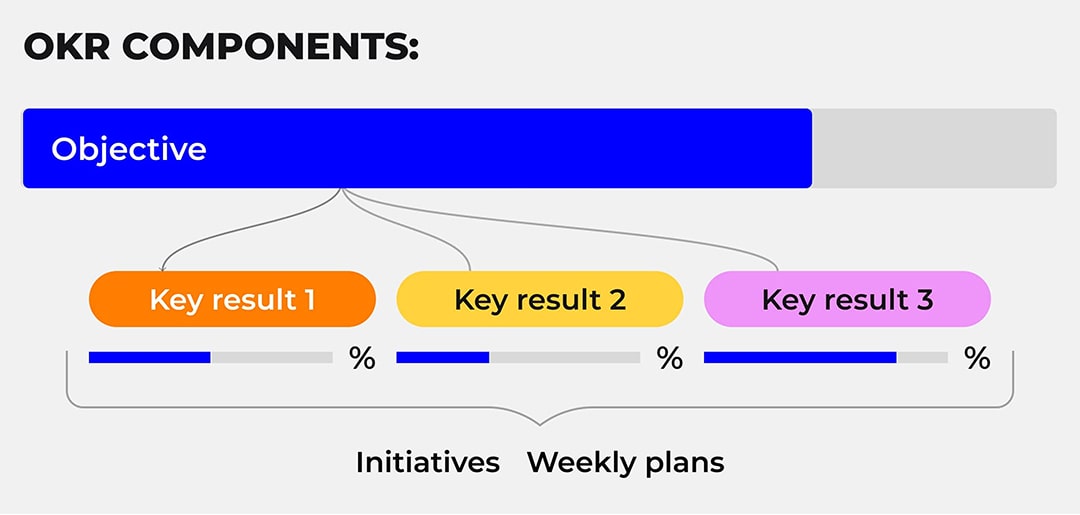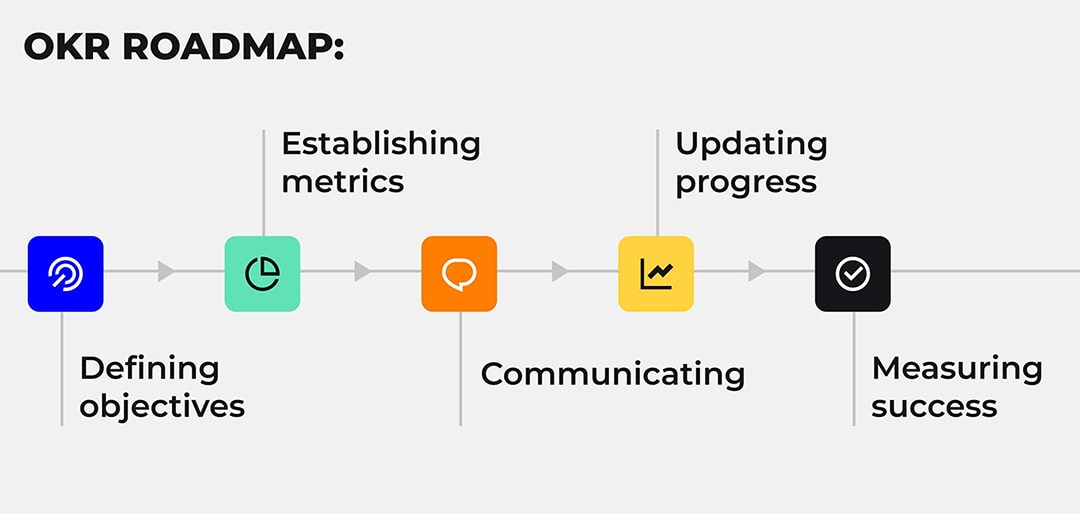Businesses looking for tech specialists to work on critical projects usually want those who align engineering efforts with business goals. Engineering teams are a major force driving business growth and success. That's why setting clear Objectives and Key Results (OKRs) can help track this alignment and maintain an engineering OKRs focus.
Let's explore how engineering teams can leverage OKRs for engineers to enhance measurement and accountability while fostering a culture of continuous improvement. Let's deep dive into best tips for implementing OKRs in your organization.
Implementing OKRs for Engineering Teams: Alignment and Strategy

Successful OKR implementation starts with business strategy. Aligning goals relies on clear and consistent communication between engineering leaders and executives. But it's not enough to just communicate the strategy; goals should be adapted into concrete actions.
Communicating a Company's Strategy
A company's mission and vision are foundational but aren't always clearly shared with all employees. To align with them, specialists need to fully understand them. Implementing top-down engineering OKRs ensures that strategic objectives are effectively communicated. Leadership should organize regular updates to inform teams about strategic priorities.
Providing a centralized repository of these objectives—like policies, handbooks, or codes of conduct—helps everyone stay on the same page. This transparency shows engineers how their work contributes to the company's success, offering clear engineer goals examples that align with company objectives.
Scheduling Regular Alignment Sessions
Regular reviews, held quarterly or monthly, let teams reassess their OKRs in light of changing business needs. These sessions also help address engineering challenges with OKRs, allowing teams to adjust their objectives as needed. Executives can inform specialists of any changes while keeping everyone focused on common goals. Being agile and adapting to new information ensures engineering resources target the most critical objectives.
Cascading Goals
Once company objectives are identified, they should be cascaded to teams and turned into measurable actions. This is what makes the OKR framework successful. By breaking down broad goals into specific, team-level objectives, organizations ensure that every engineering effort contributes directly to business success through a well-defined OKR for engineering team.
Engaging engineering teams in this goal-setting process enhances ownership. Team members can clearly see how their work reflects into a company's goals and achievements.
Avoiding Siloed OKRs
Engineering teams shouldn't operate in isolation. Promoting cross-functional collaboration with departments like marketing or sales prevents redundancy and speeds up project delivery. Tools like Jiraor Asana improve communication, while identifying dependencies across teams ensures smooth coordination and prevents delays.
To stay aligned, engineers' efforts should be measured by their impact on broader business goals, not just technical metrics. Examples include customer satisfaction or revenue growth. This keeps the focus on driving meaningful business success.
Looking to align your engineering team's efforts with your business objectives seamlessly? Outstaff Your Team can provide you with top-tier tech specialists who can help implement effective OKRs.
Hire with us
OKR Examples for Software Engineers: Measurement and Liability
OKRs should always be quantifiable to bring measurable results. Clearly defined key results allow for tracking progress. Without measurable metrics, it will be difficult to assess whether your objectives have been met. Regular reviews and data-driven insights are essential for maintaining accountability and keeping teams on course.
For instance, consider some software engineer OKR examples like “Increase code coverage from 70% to 85% this quarter” or “Reduce average page load time by 30% in the next two months.” These specific, measurable goals help teams stay focused and aligned.
Defining Quantifiable Key Results
Vague objectives lead to uncertain outcomes. To prevent this, OKRs must be specific. Applying the SMART method (Specific, Measurable, Achievable, Relevant, and Time-bound) ensures that achievements are clear indicators of success.
When objectives are well-defined, engineering teams can focus their efforts and make informed, data-driven decisions throughout the developer’s life cycle. For example, engineering OKR examples like “Increase system uptime to 99.9% over the next quarter” or “Implement automated testing to reduce bugs by 25% in the next release cycle.”
Data-Driven Metrics
Using real-time data tracking through analytics tools is vital for monitoring engineering performance. Establishing baseline metrics and setting clear deadline management at the project's start helps measure progress. Data-driven insights highlight areas needing improvement, allowing teams to make timely adjustments. Openly sharing these metrics within the team splits responsibilities and encourages a culture of ongoing improvement.
Regular Reviews and Updates
Setting up OKRs at the beginning of the year doesn't mean they remain static. They should evolve as the project advances. Since many engineering teams follow an agile approach, so should engineer OKRs. Regular check-ins are key to tracking progress, spotting challenges, and making adjustments. This keeps teams focused on high-impact goals.
Accountability and Support
Accountability starts with setting clear expectations. Performance agreements should define objectives, key results, and success criteria, ensuring transparency and personal responsibility. To motivate the team, you can link OKR success to rewards or recognition, integrating with HR operations and talent management services.
However, accountability shouldn't rest solely on team members. As a leader, you should ensure your teams have the right tools and resources, possibly through IT recruitment services or IT staff augmentation services. Providing adequate support removes barriers and empowers teams to perform at their best.
Allocating Resources and Setting Up Priorities

Efficient resource allocation is crucial for engineering teams to meet their engineering OKRs. Prioritizing high-impact objectives and staying flexible with resources ensures teams focus on what matters most while adapting to changing project demands. A strategic approach to balancing workload and resources is essential for meaningful progress.
Prioritizing OKRs for Engineers Based on Strategic Alignment
Not all OKR examples for software engineers hold the same importance. It's essential to prioritize those that align closely with strategic business goals. For example, an engineering team might set an OKR to “Reduce product deployment time by 20% in the next quarter,” an OKR examples for developers that directly supports faster time-to-market.
This can be measured through deployment cycle analytics and tracking time reductions in deployment processes. Creating a scoring system to evaluate OKRs for engineers based on factors like business impact, urgency, and ROI ensures resources focus on critical initiatives, driving greater company success.
Flexible Resource Management
Regularly reviewing resource allocation keeps it aligned with shifting priorities. As projects progress, some OKRs may need more resources, while others might need less. Continuous evaluation helps you make the best use of your engineering talent, ensuring high-priority projects get the attention they need without overloading the team.
OKR Examples for Software Engineers: Short-Term and Long-Term Goals
Balancing short-term OKRs that provide immediate impact with long-term goals essential for sustained growth is crucial. For example, a short-term, function-specific OKRs for engineers might be “Fix 95% of critical bugs in the next two weeks,” directly improving product stability and customer satisfaction.
A long-term OKR could be “Migrate 60% of the platform to cloud infrastructure within six months,” aligning with goals for scalability and innovation. By allocating resources to both types of objectives, companies address immediate needs while laying the foundation for future growth. Prioritizing projects that contribute to both maximizes ROI and operational efficiency.
Empower your engineering team with the right talent and support to overcome challenges and achieve meaningful outcomes.
Get in touch with us
Cultural Change and Adoption
Adopting OKRs for engineering teams requires shifting from task-based work to focusing on outcomes that align with business goals. To foster this change, clearly communicate the benefits of OKRs. Encouraging team involvement, celebrating wins, and addressing challenges openly can build enthusiasm and promote continuous improvement. This ensures teams not only adopt the OKR approach but also thrive within it.
Communicating the Benefits
When discussing benefits, it's important to show how the business grows and succeeds, so specialists feel they're part of the change. It's also critical to recognize individual successes. The synergy of mutual efforts brings positive results that benefit everyone.
Training and Ongoing Support
Implementing OKRs requires a mindset shift. To ensure a smooth transition, provide training workshops, detailed guides, and ongoing mentorship. These resources equip teams with the skills to set and track their OKRs effectively. Continuous support helps teams address challenges and stay on track during implementation.
Overcoming Resistance to Change
Resistance is common with new processes. Open discussions, addressing concerns, and sharing the benefits of OKRs can reduce skepticism. Involving teams in setting OKRs fosters buy-in and increases adoption. Rolling out gradually, starting with a pilot team, lets you refine the process and ensure smoother, organization-wide implementation.
Practical Examples and Insights

To turn theory into action, let's look at some real-world examples that show efficiency and measurable success.
Real-World OKR Examples
Tech giants using the OKR system demonstrate how helpful it is in achieving goals. For example, with clear objectives, Google delivered the Chrome browser, capturing a significant market share. This is one of many OKR examples for software engineers showing the impact of clear, measurable objectives.
LinkedIn is another example. They set clear goals to increase user activity in the next quarter, which they achieved. These examples show how clear, measurable OKRs can directly impact operational efficiency and customer outcomes.
Practical Tips for Your OKRs
To ensure OKR success, follow these strategies:
Define clear objectives. Objectives should be specific, easily understood, and motivating. Key results need to be quantifiable, with deadlines to track progress.
Prioritize outcomes over tasks. Focus on the desired end result, not only the process. This allows teams to innovate while staying aligned with business objectives.
Choose the right tools. Use OKR tracking tools like Asana or Jira to maintain transparency and streamline progress tracking.
Maintain consistent updates. Regularly review progress, ideally weekly, to keep momentum and alignment with company goals.
Common Misconceptions About OKRs
Several misconceptions exist among SMEs and engineering teams:
-
OKRs are only for large companies
It's not true. OKRs for engineer roles can be effective for small startups too. The key is setting clear goals and communication so teams align with strategic priorities.
-
OKRs restrain creativity
On the contrary, OKRs provide a framework that fosters creativity. By setting clear objectives, teams know what needs to be achieved but have the freedom to decide how best to get there, leading to innovative solutions.
Tailoring OKRs to Your Audience
When designing OKRs, consider specific challenges. Engineers often juggle technical debt, pressure to innovate rapidly, and the need to maintain product stability. OKRs that directly address these concerns are more likely to engage engineering teams and lead to impactful results. Tailoring OKRs to these unique pain points keeps teams motivated and focused on meaningful outcomes.
Concluding Thoughts
Aligning engineering efforts with business goals, setting measurable OKRs, and fostering an OKR-driven culture can significantly boost business growth. OKRs for engineering teams keep teams focused on high-impact projects, while continuous tracking ensures accountability. With proper support and a focus on improvement, companies can empower their engineering teams to drive meaningful contributions to overall success.
FAQ
Why are OKRs beneficial for engineering teams?
OKRs help engineering teams stay focused on key priorities while aligning their work with broader company objectives. They enhance collaboration and encourage continuous improvement culture, driving both team and organizational success.
How often should engineering teams set and review OKRs?
Engineering teams typically set and review OKRs quarterly, but this can be adjusted based on the team's pace and project needs. Regular check-ins, like bi-weekly or monthly, help teams stay aligned and make timely adjustments.
How can I prevent OKRs from becoming too overwhelming or burdensome?
To prevent OKRs from becoming overwhelming, keep them focused and concise. Limit the number of objectives to those most crucial. Prioritize key initiatives and ensure the team isn't spread too thin by tackling too many goals at once.
Ann Kuss is the CEO at Outstaff Your Team. After 11 years of expertise in building remote tech teams for startup unicorns and global tech brands, Ann decided to lead a new venture aiming to reinvent the way international tech teams scale. Throughout her career, Ann hired specialists for countless tech positions from more than 17 countries on all major continents. Ann graduated from Kyiv-Mohyla business school, is an MIM Kyiv alumna, and regularly takes part in mentorship programs for junior tech talents. Ann actively promotes knowledge sharing and curates Outstaff Your Team blog strategy, preferring topics that solve practical needs of IT leaders. She believes that structuring business flows (including hiring) is a well-planned journey with predictable and successful outcome.



